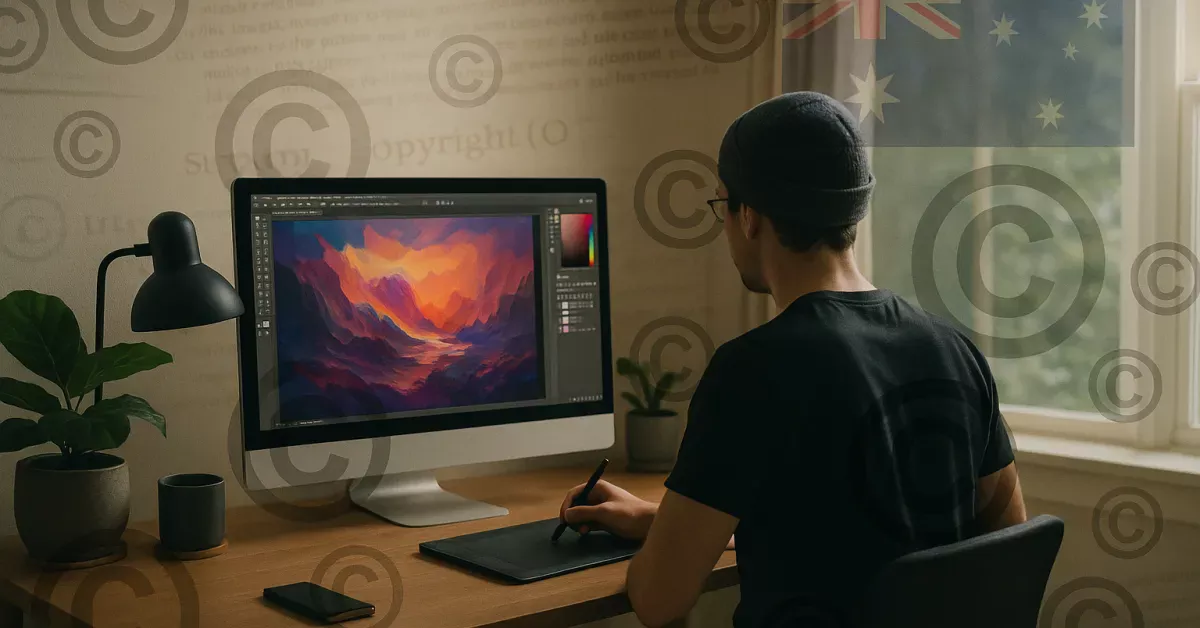Creating a website involves more than just clever design and engaging content. It’s about building a digital asset that represents your brand, ideas, or services. But once your site goes live, how do you protect all that hard work from being copied or used without your permission? Understanding copyright for your website content and images is essential for safeguarding your creative efforts.

What Copyright Actually Protects on Your Website
Many website owners mistakenly believe they can copyright their entire website. The truth is, copyright protects the original content on your site, not the website itself. According to copyright principles, protection extends to:
- Written content: Your blog posts, articles, product descriptions and general web copy
- Visual elements: Original photographs, illustrations, infographics and logos
- Multimedia: Videos, audio recordings and music you’ve created
- Design components: Unique visual elements that make your site distinctive
- Code: To some extent, the original source code you’ve written
If you created it and it’s original, it likely has copyright protection.
Automatic Protection: Your Rights Begin Immediately
Here’s good news for Australian content creators – your work is automatically protected by copyright as soon as you create it. Unlike some other forms of intellectual property, you don’t need to register or even include a copyright notice for this basic protection to exist.
As noted by the Attorney-General’s Department, Australia is party to several international copyright treaties, including the Berne Convention, which helps ensure your work is protected not just in Australia but in many countries worldwide.
Why Add a Copyright Notice?
While not legally required in Australia, adding a copyright notice to your website footer serves several practical purposes:
- It clearly signals your ownership of the content
- It deters potential infringers by making your rights obvious
- It eliminates any “I didn’t know” excuses
- It provides contact information for those seeking permission
A standard copyright notice includes:
- The © symbol or the word “Copyright”
- The year of first publication
- Your name or company name
- A statement of rights
For example: Copyright © 2025 Your Business Name. All rights reserved.
Protecting Your Images: A Special Consideration
Images are particularly vulnerable to copyright infringement online. It’s remarkably easy for someone to right-click and save your photos or graphics. To protect your visual content:
- Add watermarks to valuable images
- Use lower-resolution versions where appropriate
- Disable right-clicking (though tech-savvy users can work around this)
- Consider embedding metadata in your image files
- Regularly search for unauthorised use of your images using reverse image search tools
Using Others’ Content: Play It Safe
Just as you want protection for your content, you must respect others’ copyright. When using images or content you didn’t create:
- Use properly licensed stock photos: Ensure you understand and follow the license terms
- Get permission directly: Contact the copyright owner for explicit permission
- Use Creative Commons content: Follow the specific license requirements, which often include attribution
- Create original content: The safest approach is to create your own text and images
Remember, finding content through a Google search doesn’t make it free to use, and simply crediting the source isn’t enough to avoid copyright infringement.
Monitoring and Enforcing Your Rights
Protecting your copyright requires vigilance:
- Regularly search for copies of your content online
- Set up Google Alerts for unique phrases from your content
- Use plagiarism detection tools to find text copies
- If you find infringement, consider sending a takedown notice to the website owner or their hosting provider
International Considerations
While your work is automatically protected in Australia, international protection is governed by treaties like the Berne Convention. As Pentana Stanton Lawyers notes, there’s no need to register copyright in Australia, making it one of the most accessible forms of legal protection for businesses producing creative content.
However, if you’re particularly concerned about protection in specific countries or have highly valuable content, consulting with an intellectual property lawyer can help you understand your options.
Common Copyright Myths Debunked
Let’s clear up some misconceptions:
- Myth: Adding “© All Rights Reserved” fully protects your content
Reality: While helpful, this notice doesn’t provide additional legal protection beyond automatic copyright - Myth: If there’s no copyright notice, the content is free to use
Reality: Copyright exists whether there’s a notice or not - Myth: Changing someone else’s work by 10% makes it legal to use
Reality: There’s no “percentage rule” – substantial copying can still be infringement - Myth: If you’re not charging for it, using copyrighted content is okay
Reality: Commercial use isn’t required for copyright infringement
Practical Steps for Website Owners
To protect your website content and images:
- Add a clear copyright notice to your website footer
- Create an internal inventory of your original content
- Keep records of when content was created and by whom
- Use only properly licensed or original images
- Consider watermarking valuable images
- Include copyright terms in your website’s terms of use
- Regularly monitor for unauthorised use of your content
- Act promptly if you discover infringement
When to Seek Legal Advice
While basic copyright protection is automatic, certain situations warrant professional legal advice:
- When dealing with valuable intellectual property
- If you discover significant infringement of your work
- Before taking legal action against an infringer
- When creating contracts involving content creation
- If you receive a copyright infringement notice
Understanding copyright basics helps you protect your website content and images while respecting others’ rights. By taking simple precautions and staying informed, you can safeguard your creative work in the digital landscape.
Common Questions About Website Copyright
Website owners often have specific questions about copyright that go beyond the basics. Here are answers to some of the most important questions you might have about protecting your online content and using others’ work legally.
Copyright protection extends to the original, creative elements of your website design, but not to standard or functional elements. While you can’t copyright the concept of a navigation menu or a contact form, you can protect unique visual elements, custom graphics, and original arrangements of content. The more distinctive and creative your design, the stronger your copyright protection will be.
Yes, it can still be infringement. Copyright law protects against “substantial similarity,” not just exact copying. If someone takes your content and makes minor changes while keeping the substance of your work, they may still be infringing your copyright. Courts look at the qualitative importance of what was copied, not just the quantity.
No, you don’t need separate protection. Copyright automatically applies to all original content you create, whether it’s your static website pages or regularly updated blog posts. Each new piece of content receives its own copyright protection from the moment of creation. However, if you’re particularly concerned about valuable content, you might consider documenting when specific pieces were published.
In Australia, copyright for written content, images, and most website materials lasts for the life of the creator plus 70 years. For content created by your employees as part of their job, your business holds the copyright for the same duration. This means your website content will remain protected long after its creation, though the practical value of this protection typically diminishes over time for most website content.
Using screenshots of other websites falls into a grey area. While it may be considered fair dealing for purposes of criticism, review, or reporting news in Australia, you should be cautious. Best practices include: only using what’s necessary to make your point, providing proper attribution, ensuring your use doesn’t harm the market value of the original, and considering whether the screenshot includes third-party content that might have separate copyright protection.
In Australia, unless specified otherwise in a contract, the freelancer (not you) retains copyright ownership of content they create, even if you’ve paid for it. To ensure your business owns the copyright, you must have a written agreement that explicitly transfers copyright ownership to you. This is why it’s crucial to include clear intellectual property clauses in all contracts with content creators, designers, and developers.
Generally, embedding content using the platform’s official embedding tools is considered acceptable, as you’re not hosting the content yourself but rather linking to it. However, this is still an evolving area of law. The safest approach is to only embed content from reputable sources using official embedding features, and to remove embedded content if the original creator objects.
The copyright status of AI-generated content remains somewhat unclear under Australian law. While you might have rights to use AI-generated content based on your agreement with the AI provider, questions remain about originality and ownership. Additionally, if the AI was trained on copyrighted works without permission, there could be infringement issues. Until the law becomes clearer, it’s safest to review the terms of service for any AI tools you use and consider using AI-generated content as a starting point that you substantially modify.
Copyright infringement is a legal violation of someone’s exclusive rights to their creative work, potentially resulting in legal consequences including damages. Plagiarism is an ethical violation involving passing off someone else’s work as your own, which may damage your reputation but isn’t necessarily illegal if the content isn’t protected by copyright (such as facts or content in the public domain). Many actions constitute both—copying someone’s blog post without permission is both copyright infringement and plagiarism.
First, document the infringement by taking screenshots and noting the URL and date. Next, try to identify the website owner through WHOIS records or contact information on their site. Send a formal takedown notice (sometimes called a DMCA notice, though Australia has its own framework) to both the website owner and their hosting provider, clearly identifying your copyrighted work and requesting removal. If this doesn’t work, you might escalate to a cease and desist letter from a lawyer. As a last resort, you could consider legal action, though this can be costly and time-consuming.
Further Reading: Essential Copyright Resources for Australian Website Owners
If you want to dig deeper into copyright for website content and images in Australia, these links offer reliable, up-to-date information and practical guidance. Each resource is tailored to help you understand your rights, avoid common pitfalls, and manage your creative work with confidence.
Copyright basics | Attorney-General’s Department
A clear, official overview of how copyright works in Australia, including what’s protected, how long it lasts, and Australia’s international copyright obligations.
Copyright: the basics – MGNSW
This resource explains copyright in plain English, covering ownership, duration, moral rights, and special considerations for digital and Indigenous content.
Copyright in Australia: A Comprehensive User Guide – Lawpath
A detailed guide for creators and business owners, outlining what you can copyright, who owns it, how to protect your work, and what to do if your rights are infringed.
Understanding Copyright Protection Laws in Australia
A practical summary of copyright protection, eligibility, infringement, and legal remedies, suitable for both creators and consumers.
Does my Website Need a Copyright Notice? | LegalVision
Answers common questions about copyright notices, using others’ content, and best practices for protecting your website’s original material.
These resources will help you stay informed and make smart decisions about your website’s content and images.


